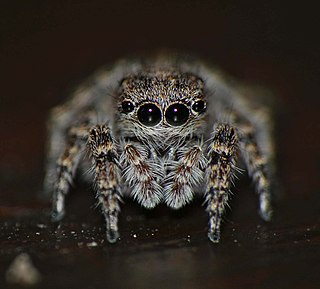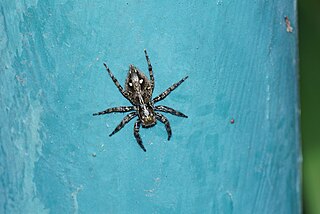
Evarcha is a genus of spiders in the family Salticidae with 85 species distributed across the world.

Langelurillus is a spider genus of the family Salticidae. All the described species occur only in Africa.
Microbianor is a genus of African jumping spiders that was first described by D. V. Logunov in 2000. The name is derived from the Ancient Greek μικρός, meaning "small", and the genus Bianor.
Cembalea triloris is a species of jumping spider in the genus Cembalea that lives in Namibia and South Africa. It was first described in 2011 by Wanda Wesołowska and Charles Haddad. The spider gets its name from the existence of three distinctive white stripes on its back, more noticeable on the male. The spider is small, with a dark brown carapace that is between 2 and 2.3 mm long and a lighter sandy or yellowish-white abdomen that is between 2.4 and 2.6 mm long. It has a large eye field and a clypeus that extends to the edge of the carapace. It can also be distinguished from other members of the genus by the large spike that protrudes from the abdomen and the male's long embolus.
Nigorella hirsuta is a species of jumping spider in the genus Nigorella that lives in South Africa and Zimbabwe. It was first describedin 2009 by Wanda Wesołowska. The spider is medium-sized, with a carapace that is between 3.5 and 4.7 mm long and an abdomen that is between 3.2 and 6.6 mm long. The female is larger than the male. The carapace is generally dark brown and hairy. While the male abdomen is similarly hairy and dark brown, the female abdomen is more grey. The species has been confused with the related Nigorella plebeja. However, it can be generally identified by the strongly sclerotized cups in the female epigyne and the male's longer embolus.
Evarcha vittula is a jumping spider species in the genus Evarcha that lives in South Africa.
Evarcha flagellaris is a jumping spider species in the genus Evarcha. It lives in Kenya and South Africa. The species was first described in 2011.
Evarcha brinki is a jumping spider species in the genus Evarcha. It has more similarities with Evarcha species from China, like Evacha sichuanensis and Evarcha orientalis, than many African species.

Langona hirsuta is a species of jumping spider in the genus Langona that lives in South Africa. It was first described in 2011 by Charles Haddad and Wanda Wesołowska. The spider is large with a carapace between 2 and 3.7 mm long and a abdomen between 1.9 and 4.4 mm long. The female is significantly larger than the male, particularly in the abdomen, which is also wider and a lighter brown. The male has very hairy pedipalps, after which it is named. It has the toothless chelicerae typical of the genus, and a single appendage, or apophysis, on the palpal tibia. The length of the apophysis helps to distinguish it from other spiders in the genus. It lives in semi-arid climates.

Langona lotzi is a species of jumping spider in the genus Langona that lives in Lesotho and South Africa. It was first described in 2011 by Charles Haddad and Wanda Wesołowska. The spider is large with a carapace that is between 2.1 and 2.8 mm long and an abdomen between 2 and 2.9 mm long. The female is larger than the male. The carapace is dark brown with a black eye field. The male abdomen is black brown with three white stripes, while the female has a plain greyish-brown abdomen. As the colouring is similar to other spiders in the genus, the species is best distinguished by its copulatory organs. The male has an unusually small embolus that has its base hidden in the palpal bulb cymbium. The female has a unique epigyne with a shallow depression lined with sclerotised wings covering the gonopores and a simple internal morphology.

Icius pulchellus is a species of jumping spider in the genus Icius that lives in South Africa. It was first described in 2011 by Charles Haddad and Wanda Wesołowska. Only the female has been described. The spider is small, with a carapace measuring between 2.0 and 2.5 mm long and an abdomen that is between 2.0 and 2.4 mm in length. It has a sickle-shaped embolus. The spider is similar to the related Icius minimus, but can be distinguished by the pattern of the abdomen, which includes a brown stripe down the middle, and its short fat tibial apophysis.
Tanzania meridionalis is a species of small jumping spider in the genus Tanzania that lives in South Africa. The male was first described in 2011.
Afraflacilla karinae is a jumping spider species in the genus Afraflacilla that lives in South Africa. A published description of the female was first made in 2011, but the male has yet to be described. It is most closely related to Afraflacilla elegans.

Pseudicius maculatus is a species of jumping spider in the genus Pseudicius that lives in Lesotho and South Africa. The spider was first defined in 2011 by Charles Haddad and Wanda Wesołowska. The spider is small, with a carapace and abdomen each that measure between 2.5 and 2.7 mm long. The carapace is chocolate-brown and covered in white hairs. The abdomen has a pattern of white patches which are more distinctive on the female. These give the species its name. It also has a characteristic longer and stouter foreleg. The species is similar to the related Pseudicius africanus, apart from the pattern on the abdomen. It also differs in its copulatory organs, particularly the sioting of the copulatory openings on the female epigyne and the shorter male embolus.
Afraflacilla altera is a species of jumping spider in the genus Afraflacilla that lives in South Africa and Zimbabwe. The spider was first defined in 2000 by Wanda Wesołowska and originally allocated to the genus Pseudicius. The spider is small, with an elongated carapace and abdomen that are between 1.6 and 17 mm and between 2.1 and 2.6 mm long respectively. The male and female are similar in size and shape, although the female is generally lighter. They have a similar pattern of three white dots on each side of the brown abdomen. The spider is superficially almost indistinguishable from other species in the genus, particularly Afraflacilla karinae and Afraflacilla venustula. It can be best differentiated by its copulatory organs, particularly the shape of the male tibial apophyses, or appendages, and the arrangement of pouches and openings on the female epigyne.
Psenuc dependens is a jumping spider species in the genus Psenuc that lives in South Africa. The species was previously allocated to the genus Pseudicius. It was first described in 2011.
Psenuc solitarius is a jumping spider species in the genus Psenuc that lives in Namibia and South Africa. The species was previously allocated to the genus Pseudicius. The female was first described in 2011.

Plexippus tsholotsho is a species of jumping spider in the genus Plexippus that lives in South Africa and Zimbabwe. It was first described in 2011 by the Polish arachnologist Wanda Wesołowska. The species was first found in the Zimbabwean district of Tsholotsho, after which the species is named. Only the female has been described. It is a large spider, with a cephalothorax 4 mm (0.16 in) long and abdomen 5.2 mm (0.20 in) long. It is generally dark brown in colour, with a lighter brownish orange tint to the rear of the carapace and a white stripe along the body of the abdomen. It is distinguished from the otherwise similar Plexippus paykulli in the shape of the copulatory ducts in the epigyne and the presence of significant sclerotization around the gonopores.
Microbianor furcatus is a jumping spider species of the genus Microbianor that lives in South Africa. The male was first identified in 2013.
Rhene lingularis is a species of jumping spider in the genus Rhene that can be found in South Africa. The male was first identified in 2011. It is typical of the genus, and is small, dark brown and hairy. The spider is distinguished by its tongue-shaped embolus, from which its species name derives.





